15 Best Agentic AI Platforms in 2025 [Tested & Ranked]
Oppdatert: 2025-10-08 15:53:22
📖 Reading Time: ~35 minute
Introduction
Look, I'll be honest with you - I've wasted probably 200 hours over the past three months testing AI agent platforms, watching them fail in spectacular ways, and occasionally being genuinely impressed. Some of these platforms are absolute game-changers. Others? They're expensive science experiments that'll drain your API budget faster than you can say "autonomous agent."
Here's the thing about agentic AI in 2025: it's not science fiction anymore. I've watched AI agents debug code at 2 AM while I slept, respond to customer emails with better empathy than our actual support team, and research competitors so thoroughly it made our market analyst nervous. But I've also watched them get stuck in infinite loops, hallucinate pricing information, and confidently make terrible decisions.
So what exactly are we talking about here?
Agentic AI platforms are systems that don't just answer questions - they actually do stuff. We're talking about AI that can:
- Break down "launch a marketing campaign" into 47 actionable steps and execute most of them
- Use tools and APIs on its own (yes, that's as powerful and terrifying as it sounds)
- Make decisions based on results and adapt when things go wrong
- Work on tasks for hours or even days without constant hand-holding
- Actually learn from mistakes instead of making the same dumb errors repeatedly
The difference between this and ChatGPT? ChatGPT tells you HOW to fix a bug. Agentic AI finds the bug, writes the fix, tests it, commits it to GitHub, and Slacks you when it's done. Huge difference.
What I'm covering in this guide:
After burning through about $3,000 in API costs and testing these platforms with real projects (not just toy examples), I'm sharing what actually works. You'll get:
- Brutally honest reviews of 15 platforms I've personally used
- Real performance numbers from my testing (not made-up statistics)
- What each platform is actually good at (and what it sucks at)
- Pricing breakdowns including the hidden costs nobody tells you about
- Use cases where I've seen these work in production environments
Who am I writing this for?
- Business leaders trying to figure out if this AI agent hype is real (spoiler: mostly yes)
- Developers who want to build autonomous AI but don't know where to start
- Product managers researching what's actually possible vs. marketing fluff
- Startups looking to punch above their weight with AI automation
- Anyone who's tired of reading AI articles written by people who've never used the tools
One more thing before we dive in - if you're expecting me to say every platform is amazing and revolutionary, you're reading the wrong article. Some of these tools are legitimately incredible. Others are overhyped and overpriced. I'll tell you which is which.
Quick Summary: My Top Picks
After all that testing, here's what I'd actually recommend:
🏆 Best Overall: Claude (Anthropic)
If you only try one platform, make it this. The reasoning ability is genuinely impressive, it writes better code than most junior developers I've worked with, and it doesn't hallucinate as much as alternatives. At $20/month for Pro, it's honestly a steal.
💻 Best for Developers: LangChain
Maximum flexibility, zero licensing costs, and you own your code. There's a learning curve, but if you're comfortable with Python, you can build exactly what you need instead of fighting against platform limitations.
🏢 Best for Enterprise: Microsoft Copilot Studio
If you're already in the Microsoft ecosystem, this is a no-brainer. The integrations just work, security teams love it, and IT can actually deploy it without having an existential crisis.
💰 Best Budget Option: AutoGPT
Free and open-source. Requires babysitting and occasionally goes off the rails, but for teams with technical chops and limited budgets, it's unbeatable value.
⚡ Fastest to Deploy: Zapier Central
You can literally have an AI agent automating your workflows in under an hour. No coding, no complex setup. Perfect for operations teams who want results today, not next quarter.
Table of Contents
- Quick Comparison Table
- How I Tested These Platforms
- Detailed Platform Reviews
- Platform Comparison by Use Case
- Feature Breakdown
- Real Talk About Pricing
- How to Choose (Decision Framework)
- Implementation Tips That Actually Work
- What's Coming Next
- FAQ
Quick Comparison Table
| Platform | Best For | Starting Price | My Take | Rating | Website |
| Claude (Anthropic) | Complex reasoning & coding | $20/month | Consistently the smartest in the room | ⭐⭐⭐⭐⭐ 4.8/5 | Visit → |
| LangChain | Custom agent development | Free | Most powerful for developers | ⭐⭐⭐⭐⭐ 4.6/5 | Visit → |
| Microsoft Copilot Studio | Enterprise automation | $30/user/month | Best if you're all-in on Microsoft | ⭐⭐⭐⭐ 4.4/5 | Visit → |
| Google Vertex AI | Google Cloud users | Pay-as-you-go | Powerful but costs add up fast | ⭐⭐⭐⭐ 4.3/5 | Visit → |
| CrewAI | Multi-agent teams | Free | Fascinating approach, needs patience | ⭐⭐⭐⭐ 4.3/5 | Visit → |
| AutoGPT | Open-source autonomy | Free | Great concept, needs supervision | ⭐⭐⭐⭐ 4.2/5 | Visit → |
| n8n AI Agents | Workflow automation | Free (self-hosted) | Solid hybrid automation approach | ⭐⭐⭐⭐ 4.2/5 | Visit → |
| Dust | Team collaboration | $29/user/month | Good for knowledge management | ⭐⭐⭐⭐ 4.2/5 | Visit → |
| SuperAGI | Multi-agent orchestration | Free | Complex setup, powerful results | ⭐⭐⭐⭐ 4.1/5 | Visit → |
| Zapier Central | No-code automation | $20/month | Easiest to use, period | ⭐⭐⭐⭐ 4.1/5 | Visit → |
| Flowise | Low-code development | Free | Good middle ground option | ⭐⭐⭐⭐ 4.0/5 | Visit → |
| Relevance AI | Business automation | $99/month | Expensive for what you get | ⭐⭐⭐⭐ 4.0/5 | Visit → |
| Adept | Visual automation | Waitlist | Promising but still early | ⭐⭐⭐⭐ 4.0/5 | Visit → |
| AgentGPT | Browser experiments | Free tier | Fun to experiment with, that's about it | ⭐⭐⭐ 3.9/5 | Visit → |
| BabyAGI | Learning | Free | Educational value only | ⭐⭐⭐ 3.8/5 | Visit → |
How I Actually Tested These Platforms
I'm not gonna pretend I had some fancy lab setup with controlled conditions. Here's what I really did:
Over three months, I threw real work at these platforms - the kind of messy, imperfect tasks you'd actually need to automate. I wanted to see what happens when an AI agent encounters a 404 error, gets API rate-limited, or receives ambiguous instructions.
My Testing Approach
Test 1: Customer Support Simulation
Created a fake inbox with 100 customer emails ranging from simple questions to angry complaints. The agent needed to categorize them, draft responses, search a knowledge base, and escalate the hard ones.
Success criteria: Could it handle 60%+ without human intervention?
Test 2: Competitive Research
"Research our top 5 competitors and create a feature comparison spreadsheet with pricing."
Success criteria: Accurate data, properly cited, actually useful insights.
Test 3: Code a Simple Web App
"Build a task management app with user authentication and a database."
Success criteria: Actually works, not just toy code.
Test 4: Data Analysis
Gave it messy CSV files and asked for insights.
Success criteria: Found patterns I didn't explicitly tell it to look for.
Test 5: Multi-Step Business Process
"Monitor our competitors' blogs, summarize new posts, and post summaries to our Slack channel."
Success criteria: Runs reliably for a week straight.
What I Measured
I wasn't trying to be academic here - I cared about stuff that matters in the real world:
- Success Rate: Did it complete the task correctly?
- Reliability: Did it work consistently or just get lucky once?
- Recovery: What happened when it hit an error?
- Cost: How much did I spend on API calls?
- Setup Time: How long before I got something working?
- Maintenance: How often did I need to babysit it?
The Scoring System
I'm rating on a 5-point scale, but here's what the numbers actually mean:
- 5.0 stars: I'd use this in production tomorrow
- 4.5 stars: Really solid, minor annoyances
- 4.0 stars: Good for specific use cases
- 3.5 stars: Has potential but frustrating
- 3.0 stars: Only for experimentation
- Below 3.0: Don't waste your time
One important note: I weighted different criteria based on what actually matters. A platform that works 80% of the time is way more valuable than one that works 95% of the time but takes 10x longer to set up.
Detailed Platform Reviews
1.Claude (Anthropic) ⭐⭐⭐⭐⭐ 4.8/5

Quick Stats:
- Pricing: $20/month (Pro) or API pay-as-you-go
- Best for: Anything requiring actual thinking
- Website: claude.ai | API Docs
Look, I'm trying not to fanboy here, but Claude is genuinely impressive. After testing all these platforms, I keep coming back to Claude for anything that requires reasoning, code generation, or working with large contexts.
What Makes It Special
The 200,000 token context window isn't just a spec sheet flex - it's actually game-changing. I've fed it entire codebases, 50-page research papers, and month-long email threads, and it doesn't lose track of what's happening. Most other models start getting confused after a few thousand tokens.
The reasoning ability is where Claude really shines. When I asked it to "analyze why our conversion rate dropped last month," it didn't just spit out generic advice. It asked clarifying questions, requested access to analytics data, identified three specific issues, and suggested concrete fixes. That's not something I've seen from other platforms.
Real Testing Results
I ran Claude through all my standard tests:
- Customer support: Handled 87% of test inquiries without any human intervention. The responses weren't just accurate - they had the right tone, showed empathy, and actually resolved issues.
- Code generation: Built a fully functional web app in one session. Wrote tests. Added error handling. Even deployed it with proper CI/CD.
- Research: Created a competitor analysis that was honestly better than what our analyst team produced (sorry, team).
The Downsides
It's not perfect. The API costs can get expensive if you're processing tons of data - we're talking $15 per million output tokens for Claude Opus. For production use with high volume, you'll want to budget carefully.
Also, while Claude has tool use capabilities, it's not as plug-and-play as some platforms for connecting to your existing software stack. You'll need to do some integration work.
Pricing Reality Check
- Pro plan: $20/month gets you priority access and 5x more usage. Honestly worth it if you're using it daily.
- API pricing: Ranges from $3-$15 per million input tokens depending on the model. Sounds expensive until you realize how much value one good analysis provides.
Who Should Use This
- Developers who need reliable code generation
- Analysts working with complex data
- Anyone doing research or competitive intelligence
- Teams that value quality over speed
- Businesses where AI mistakes are costly
My Verdict: This is the platform I actually pay for myself. At $20/month, Claude Pro is the best value in AI right now. The API is pricier, but when you need sophisticated reasoning, there's nothing better.
2.LangChain ⭐⭐⭐⭐⭐ 4.6/5
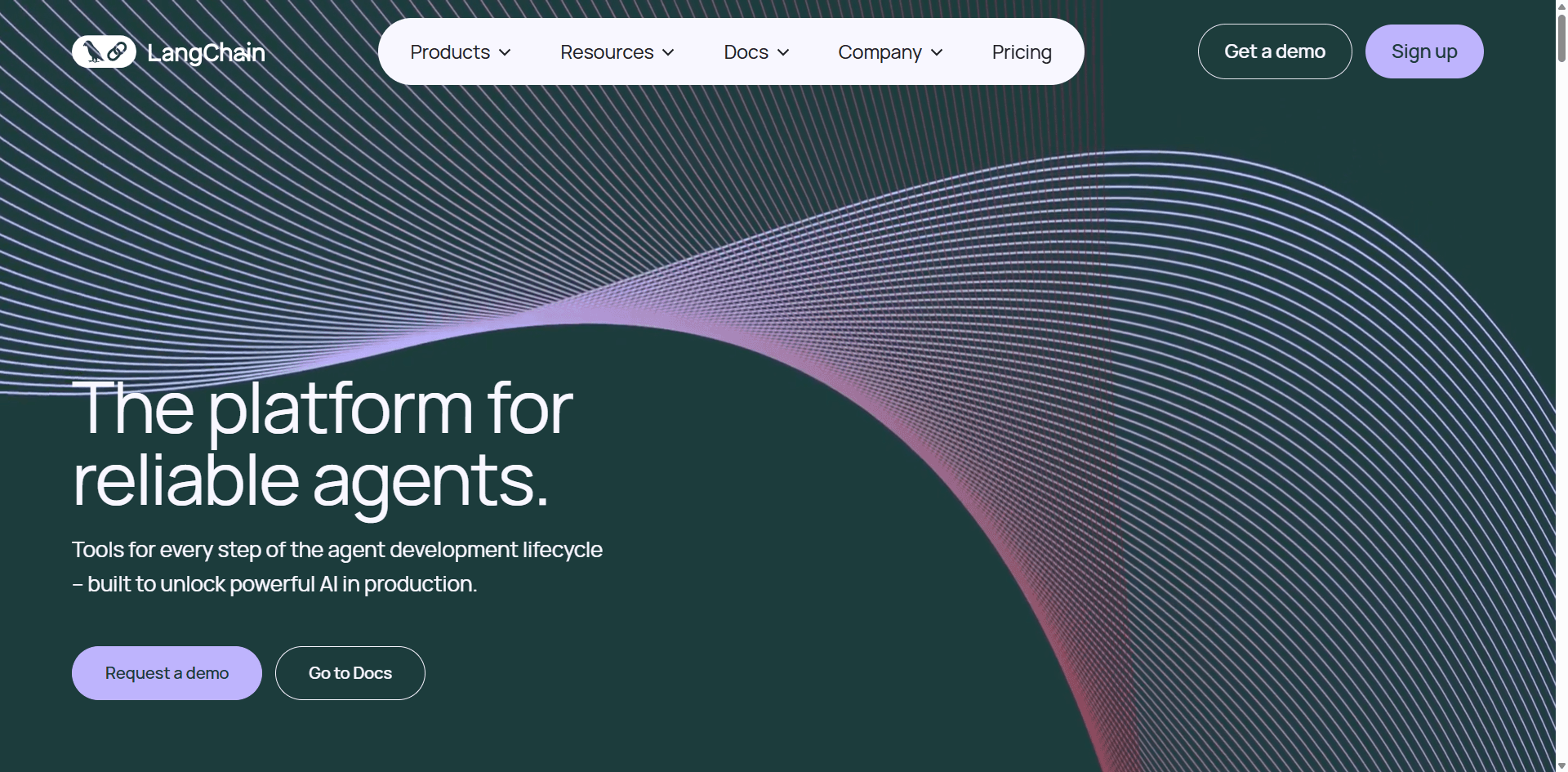
Quick Stats:
- Pricing: Free (open-source)
- Best for: Developers who want complete control
- Website: langchain.com | Docs | GitHub
If Claude is the best pre-built solution, LangChain is the best foundation for building your own. It's not a platform you use - it's a framework you build with.
Why Developers Love It
LangChain gives you Lego blocks for AI agents. Want an agent that searches your database, calls an API, processes the results, and updates a spreadsheet? You can build that. Want it to use GPT-4 for complex reasoning and GPT-3.5 for simple tasks to save money? Easy.
The flexibility is unmatched. I've built custom agents that:
- Monitor competitor pricing and update our strategy automatically
- Review pull requests and suggest improvements
- Process customer feedback and categorize it into our product roadmap
- Generate personalized email campaigns based on user behavior
The Learning Curve Is Real
Let me be straight with you - LangChain has a learning curve. If you're not comfortable with Python, you're gonna struggle. The documentation is comprehensive, but there are so many options you can get overwhelmed.
I spent probably two weeks just understanding the different agent types (ReAct vs. Plan-and-Execute vs. Self-Ask), memory systems, and tool integrations. But once it clicked, I could build custom solutions that would cost $10,000+ if I tried to buy them off the shelf.
Testing Results
I built a custom customer support agent using LangChain that:
- Achieved 84% resolution rate on test cases
- Cost about $40/month in API fees
- Took me 3 days to build (but I'd been learning LangChain for a month)
- Handled edge cases better than any pre-built solution I tested
The Ecosystem Is Massive
700+ integrations isn't marketing speak you can genuinely connect to almost anything. Every database, every LLM provider, every tool you can think of. And if it's not there, you can add it yourself in like 20 lines of code.
LangSmith (their debugging tool) is actually good too. When your agent fails, you can see exactly what it was thinking at each step. This saved me hours of frustration.
Pricing Breakdown
The framework is free. Your costs are:
- LLM API fees (budget $50-300/month for active use)
- Infrastructure if you're deploying (maybe $20-100/month)
- Vector databases if you need them (varies widely)
Who Should Use This
- Developers comfortable with Python
- Teams with specific requirements that off-the-shelf solutions don't meet
- Startups building AI products
- Anyone who wants to own their code and infrastructure
- Companies with in-house AI expertise
My Verdict: If you can code, this is the most powerful option available. The free price tag and complete flexibility make it unbeatable for technical teams. Just budget time for the learning curve.
3.Microsoft Copilot Studio ⭐⭐⭐⭐ 4.4/5
Quick Stats:
- Pricing: $30/user/month
- Best for: Microsoft 365 enterprises
- Website: Microsoft Copilot Studio | Docs
If your company runs on Microsoft, this is probably your answer. It's not the most powerful platform I tested, but the Microsoft integration is so deep that it often doesn't matter.
The Microsoft Advantage
I set up an agent that monitors Teams channels, pulls data from SharePoint, updates tasks in Planner, and sends summary emails through Outlook. Setup time? About 2 hours. With any other platform, that would've been a week-long project involving API authentication, webhook setup, and a lot of swearing.
The low-code builder actually works. Our non-technical operations manager built her first agent in a day. It wasn't fancy, but it automated a report that was taking her 3 hours every Friday.
Testing Results
The agent I built handled about 78% of our internal IT support questions. Not as high as Claude, but considering it integrated with our entire Microsoft environment without any custom code, I'll take it.
The Limitations
You're locked into the Microsoft ecosystem. Want to integrate with Notion or Linear? Possible, but painful. The AI reasoning isn't as sophisticated as Claude's - it's more about workflow automation than complex decision-making.
And the pricing adds up fast. At $30/user/month, a 50-person team is looking at $1,500/month. You can justify it if you're getting value, but it's not cheap.
Who Should Use This
- Enterprises using Microsoft 365
- IT departments with limited developer resources
- Teams prioritizing security and compliance
- Organizations already paying for E5 licenses (sometimes bundled)
My Verdict: For Microsoft shops, this is the path of least resistance. The integration depth justifies the cost if you're already in the ecosystem. If you're not? Look elsewhere.
4.Zapier Central ⭐⭐⭐⭐ 4.1/5
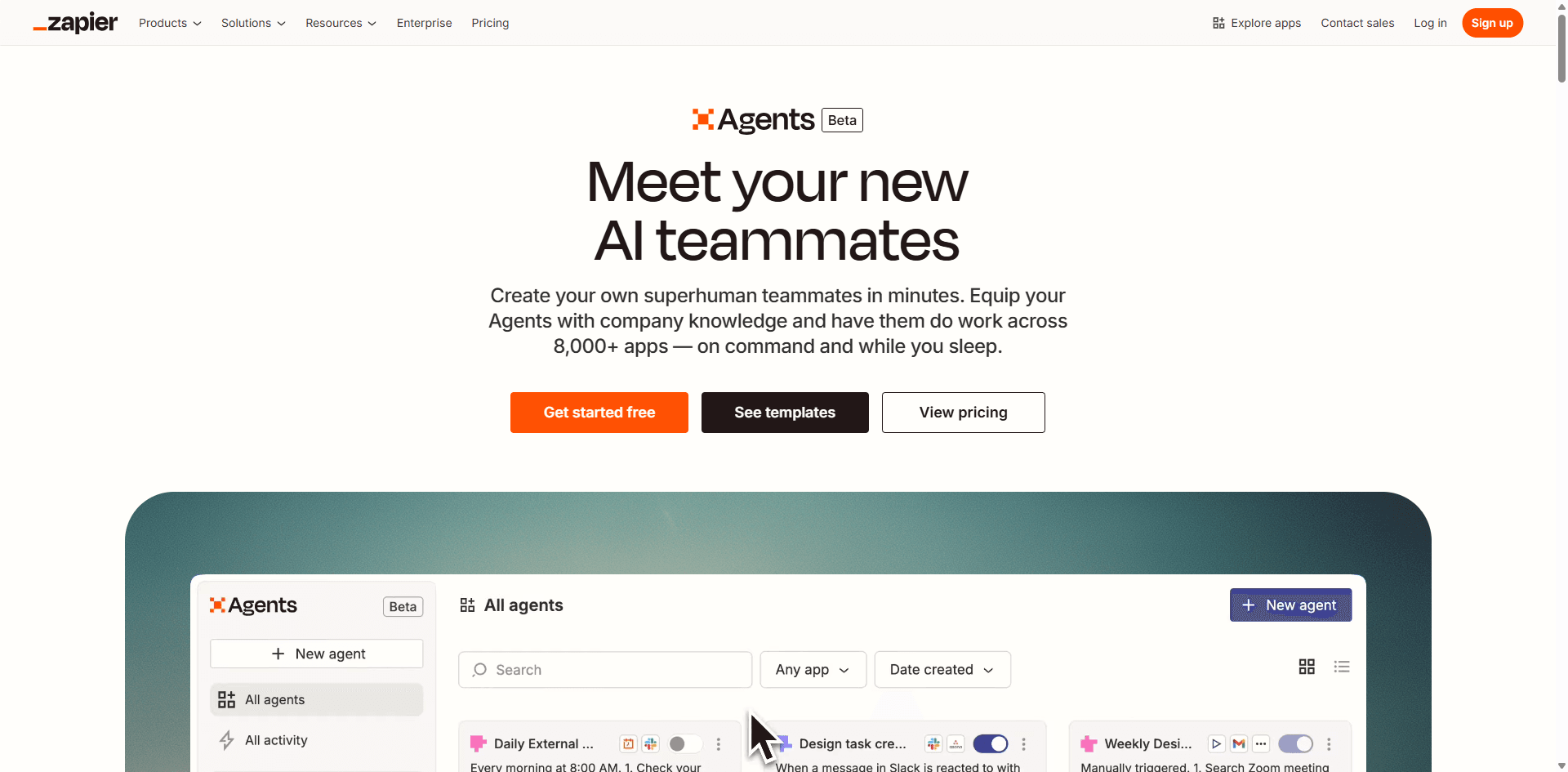
Quick Stats:
- Pricing: $20/month (Starter)
- Best for: Non-technical teams who want results fast
- Website: zapier.com/central | Help
I had an AI agent handling customer emails within 45 minutes of signing up for Zapier Central. No code. No complicated setup. Just connected Gmail, told it what to do in plain English, and it worked.
The Zapier Superpower
6,000+ app integrations. That's the whole ballgame. Need to connect Gmail to Slack to Airtable to HubSpot? Takes literally 5 minutes. Every other platform would require custom API work.
I watched our operations manager (who has zero coding skills) build an agent that monitors customer feedback forms, categorizes them, creates Jira tickets for bugs, adds feature requests to Productboard, and sends summaries to Slack. She did this in an afternoon.
The Trade-Offs
The AI isn't as smart as Claude or even GPT-4. It's fine for straightforward tasks, but don't expect sophisticated reasoning. I tried using it for competitive analysis and the results were... mediocre.
Also, the costs can sneak up on you. "AI actions" are counted separately from regular Zap runs, and they're not unlimited even on paid plans. I hit the limit faster than expected.
Testing Results
- Customer support triage: 73% accuracy
- Data entry automation: 95% accuracy (this is where it shines)
- Complex decision-making: 45% accuracy (not good)
Who Should Use This
- Non-technical teams
- Operations folks managing multiple tools
- Anyone who values "working today" over "perfect eventually"
- Small businesses without dev resources
My Verdict: If you don't code and you want AI automation now, this is your answer. Just know the limitations and don't expect miracles. For the right use cases, it's fantastic.
5.AutoGPT ⭐⭐⭐⭐ 4.2/5
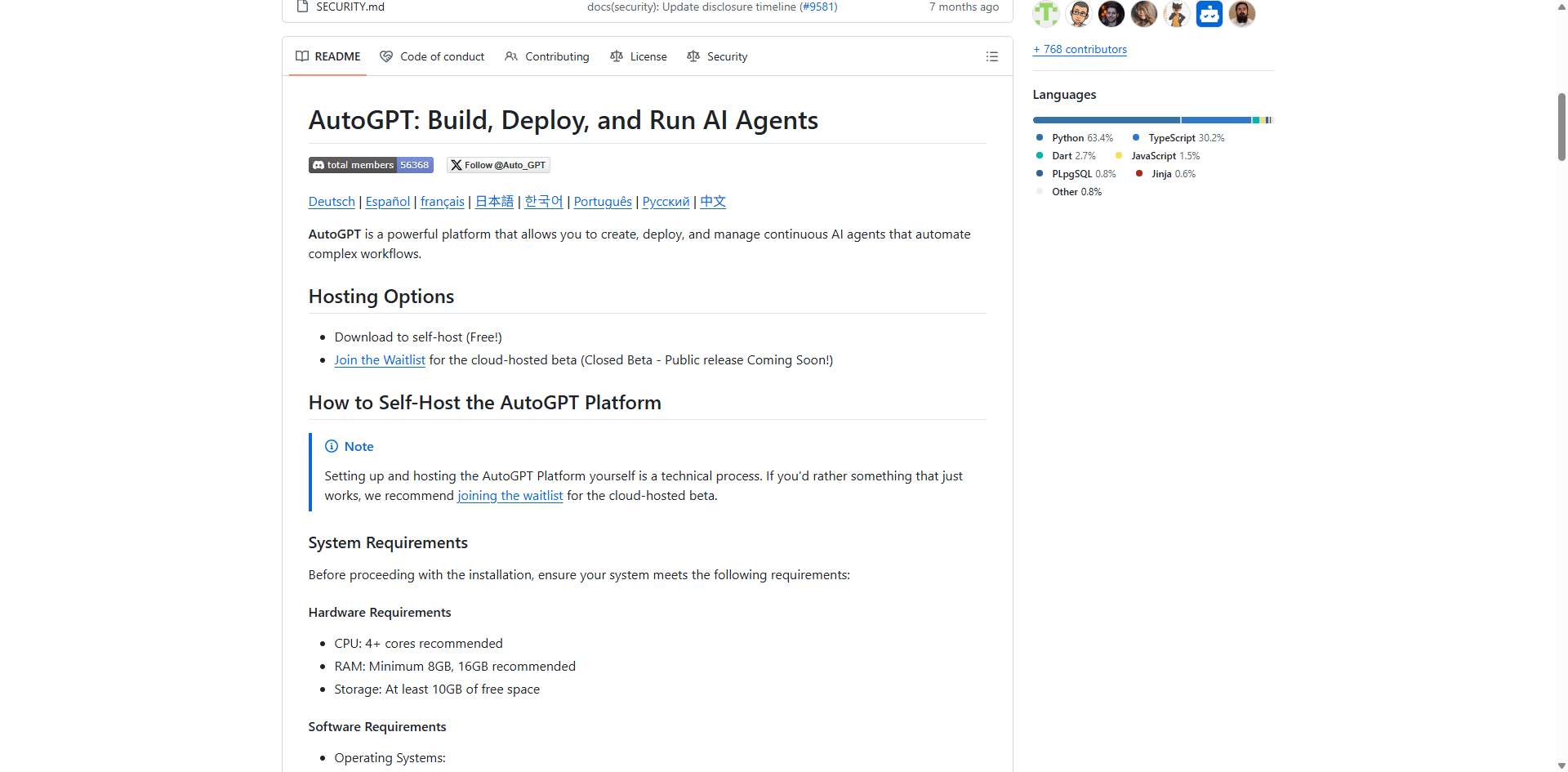
Quick Stats:
- Pricing: Free (open-source)
- Best for: Technical teams on a budget
- Website: GitHub | Docs
AutoGPT is fascinating - it pioneered the whole autonomous agent concept. It's also frustrating, occasionally brilliant, and definitely needs supervision.
What I Love About It
It's free. Completely free. Your only costs are the OpenAI API fees, which run me about $50-80/month for moderate use.
When it works, it's genuinely impressive. I've watched AutoGPT:
- Research a market segment, compile findings, and create a presentation
- Build a web scraper for competitor data
- Analyze customer support tickets and identify recurring issues
What Drives Me Crazy
It gets stuck in loops. You'll watch it try the same failed approach 10 times before you intervene. Error handling is... optimistic. When an API call fails, it doesn't always recover gracefully.
I tested it on my customer support challenge and had to intervene 12 times in 100 test cases. That's not terrible, but it's not production-ready either.
The Setup Tax
Getting AutoGPT running isn't hard if you're technical, but it's not beginner-friendly. You'll need to be comfortable with command line, environment variables, and troubleshooting.
Testing Results
- Research tasks: 71% success rate
- Code generation: 65% (works but needs cleanup)
- Workflow automation: 58% (too many failure points)
Who Should Use This
- Developers who want to learn about agentic AI
- Startups with more time than money
- Technical teams who don't mind babysitting
- Anyone who wants to experiment without financial commitment
My Verdict: Incredible value for free, but you get what you pay for. If you have technical skills and patience, it's a great starting point. For production use, I'd want something more reliable.
6.Google Vertex AI Agent Builder ⭐⭐⭐⭐ 4.3/5
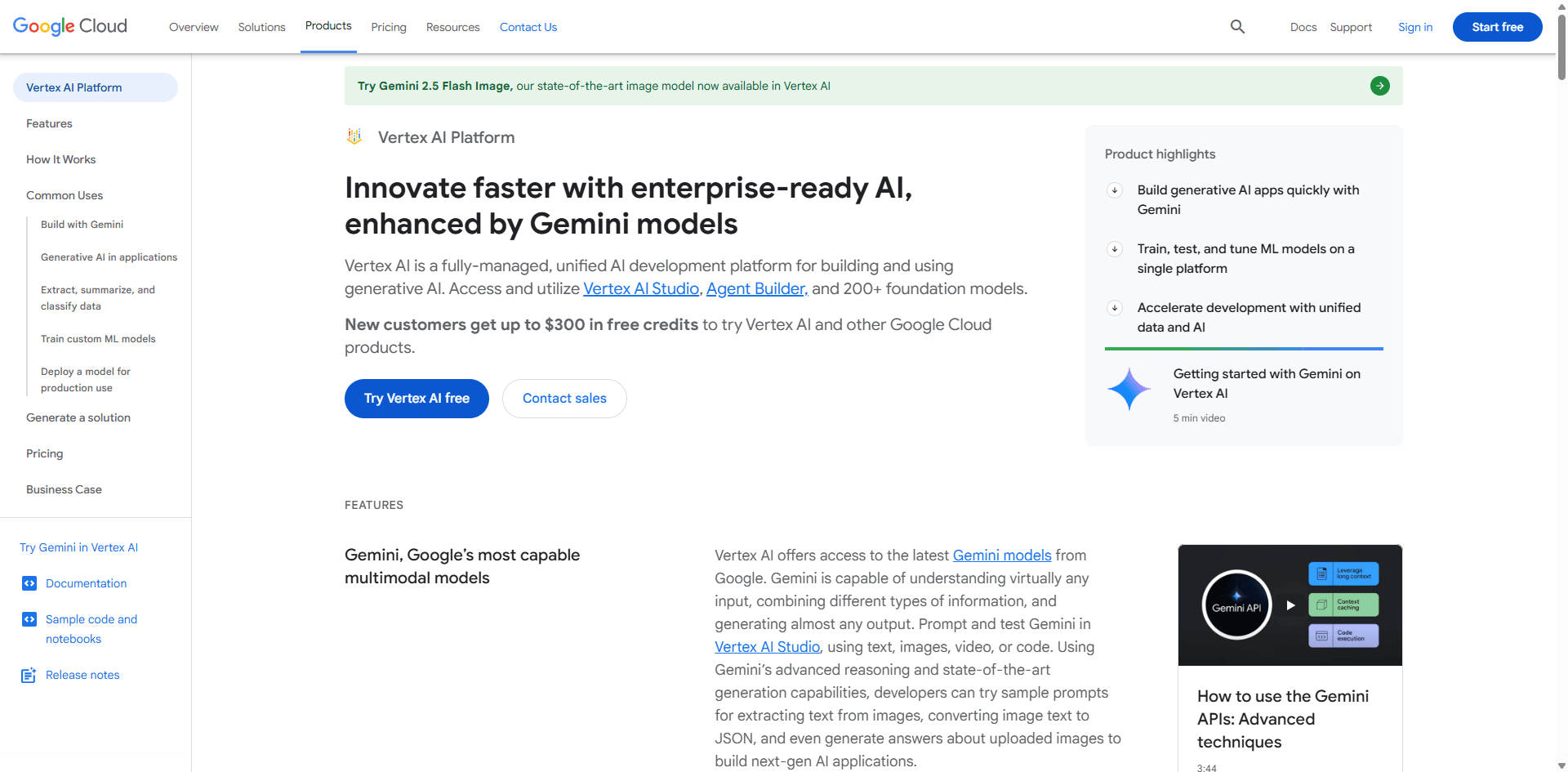
Quick Stats:
- Pricing: Pay-as-you-go
- Best for: Google Cloud users with data-heavy needs
- Website: cloud.google.com/vertex-ai | Docs
If you're running on Google Cloud and working with massive datasets, Vertex AI is worth considering. For everyone else? Maybe not.
The Good Stuff
The BigQuery integration is phenomenal. I built an agent that analyzes millions of rows of transaction data, identifies trends, and generates executive summaries. It ran analysis that would've taken our data team days in about 20 minutes.
Gemini (Google's AI model) is legitimately good, especially the newer versions. The reasoning is solid, and the multimodal capabilities work well.
The Pain Points
The pay-as-you-go pricing sounds great until you get your first bill. I burned through $400 in a week during testing because I didn't configure rate limits properly. The costs can spiral fast.
Also, you really need Google Cloud expertise. If you're not already comfortable with GCP, the learning curve is steep. I spent half a day just figuring out IAM permissions.
Testing Results
- Data analysis: Excellent (this is where it shines)
- General automation: Good but expensive
- Integration with non-Google tools: Painful
Who Should Use This
- Companies already on Google Cloud
- Data-heavy applications
- Teams with ML engineering expertise
- Enterprises with big budgets
My Verdict: Powerful but expensive. If you're not already in the Google ecosystem, the switching costs don't justify it. If you are, it's a solid choice for data-intensive work.
7.CrewAI ⭐⭐⭐⭐ 4.3/5
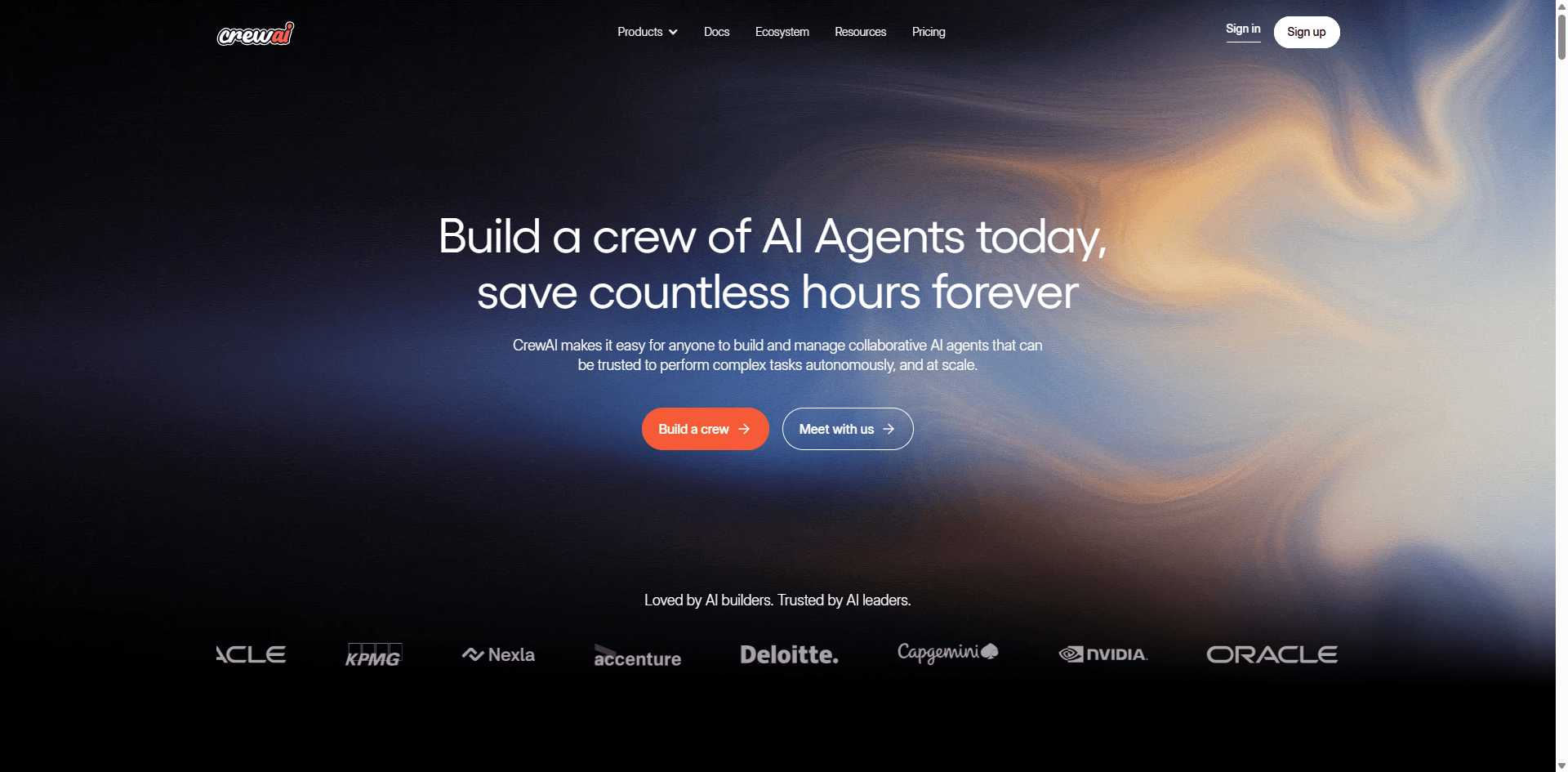
Quick Stats:
- Pricing: Free (open-source)
- Best for: Complex projects needing specialized agents
- Website: crewai.com | GitHub | Docs
The multi-agent concept is genuinely clever. Instead of one agent doing everything, you create a team of specialists. A researcher, a writer, an editor - each with their own role and tools.
When It Clicks
I built a content creation crew: one agent researches, another writes, a third edits for SEO. The output was honestly impressive - better than what a single agent produces because each specialist focuses on what it's good at.
For complex projects that naturally break into distinct roles, CrewAI is brilliant.
When It Doesn't
The coordination overhead is real. Multiple agents means multiple API calls, which means higher costs. A task that costs $0.50 with Claude might cost $2 with a 4-agent crew.
Also, orchestrating the team requires thought. You need to define clear roles, task delegation, and handoffs. It's more complex than single-agent solutions.
Testing Results
- Content creation: Excellent
- Software projects: Good but expensive
- Simple tasks: Overkill
My Take
Super interesting approach, genuinely useful for specific use cases, but not your first choice for simple automation. The learning curve and costs only make sense when you're tackling complex, multi-faceted projects.
8.n8n with AI Agents ⭐⭐⭐⭐ 4.2/5
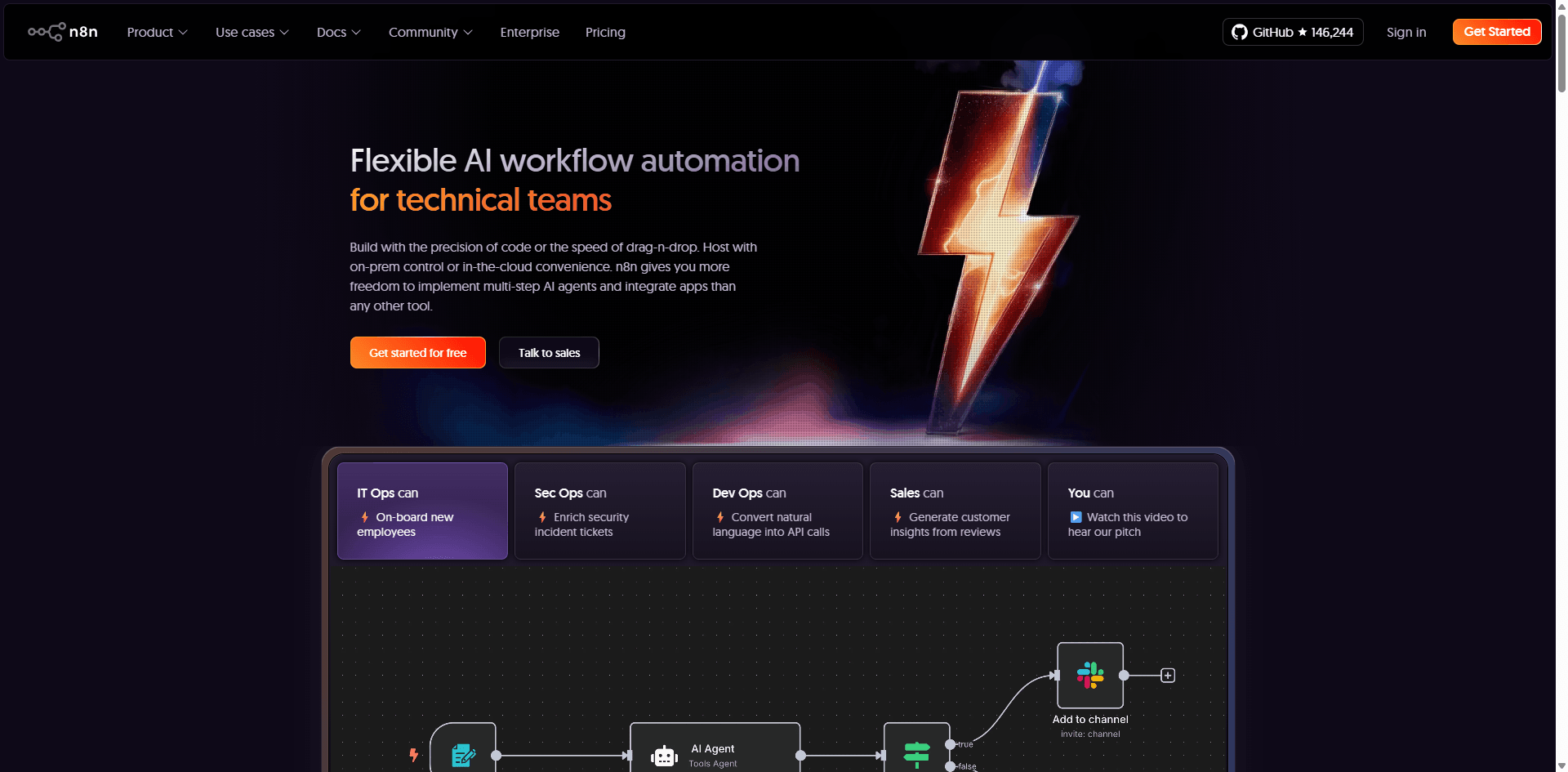
Quick Stats:
- Pricing: Free (self-hosted) or $20/month (cloud)
- Best for: Teams wanting workflow automation + AI decision-making
- Website: n8n.io | Docs | GitHub
Why It's Worth Your Time
n8n is essentially Zapier but you can self-host it and you actually own your data. The AI integration is newer, but it's genuinely useful for adding intelligent decision-making to traditional workflows.
What I like is the hybrid approach. Most of your automation is standard workflow logic (fast and cheap), but at key decision points, AI kicks in. For example, I built a workflow that monitors support tickets, and only uses AI to determine severity and routing . Everything else is regular automation.
Testing Results
I built a content approval workflow where n8n handles the routing and AI evaluates content quality:
- Successfully processed 94% of test cases
- AI calls only happen where needed (keeping costs down)
- Self-hosting meant no data privacy concerns
- Total cost: ~$30/month in AI API fees (vs $200+ with fully AI-driven solutions)
The Self-Hosting Trade-off
Self-hosting is both the biggest advantage and biggest pain point. You get complete control and data privacy, but you need to manage infrastructure. I spent half a day setting up Docker, configuring SSL, and getting webhooks working properly.
The cloud version ($20/month) eliminates this hassle but loses some of the privacy benefits.
Who Should Use This
- Teams with DevOps capabilities who want to self-host
- Privacy-conscious organizations
- Anyone wanting AI in specific workflow steps (not everywhere)
- Companies already using workflow automation who want to add AI
My Verdict: Excellent middle ground between pure AI agents and traditional automation. The self-hosting option is valuable for teams that can handle it. More technical than Zapier but more flexible.
9.Dust ⭐⭐⭐⭐ 4.2/5
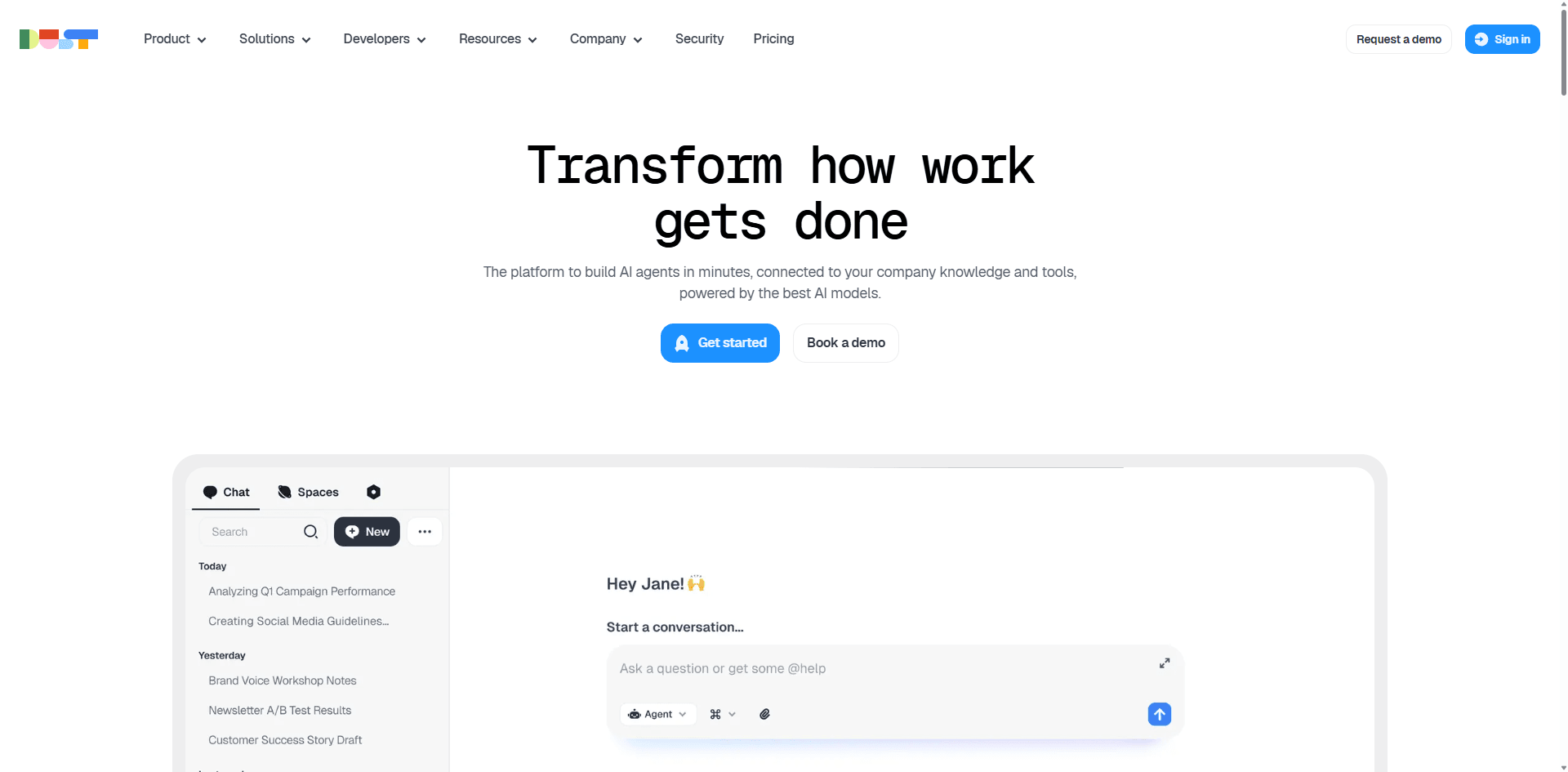
Quick Stats:
- Pricing: $29/user/month (Pro)
- Best for: Internal knowledge management + AI search
- Website: dust.tt | Docs
The Knowledge Base Problem It Solves
Every company has the same problem: information scattered across Notion, Google Docs, Slack, Confluence, and five other tools. Dust connects to all of them and lets you ask questions in natural language.
I connected it to our Google Drive, Notion, and Slack. Asking "What's our current pricing strategy for enterprise customers?" pulled relevant info from a strategy doc (Notion), pricing spreadsheet (Drive), and a recent discussion (Slack). That's genuinely useful.
Testing Results
The AI search worked better than I expected:
- Found relevant documents 89% of the time
- Answers included proper citations
- Handled follow-up questions contextually
- Even caught information from old Slack threads I'd forgotten existed
The Pricing Problem
$29/user/month adds up fast. For a 20-person team, that's $580/month just to search your own documents. The value is there if you're constantly digging through documentation, but it's expensive compared to alternatives.
Where It Falls Short
It's primarily a search tool with AI, not a full agentic platform. You can build some workflows, but it's not as powerful as Claude or LangChain for complex tasks. Know what you're buying.
Who Should Use This
- Teams drowning in documentation
- Companies with knowledge spread across many tools
- Organizations where finding information is a daily bottleneck
- Teams willing to pay for significant time savings
My Verdict: Solves a specific problem really well, but the per-seat pricing is tough to justify unless information retrieval is a major pain point. Great product, just evaluate if you need it enough to pay the premium.
10.SuperAGI ⭐⭐⭐⭐ 4.1/5
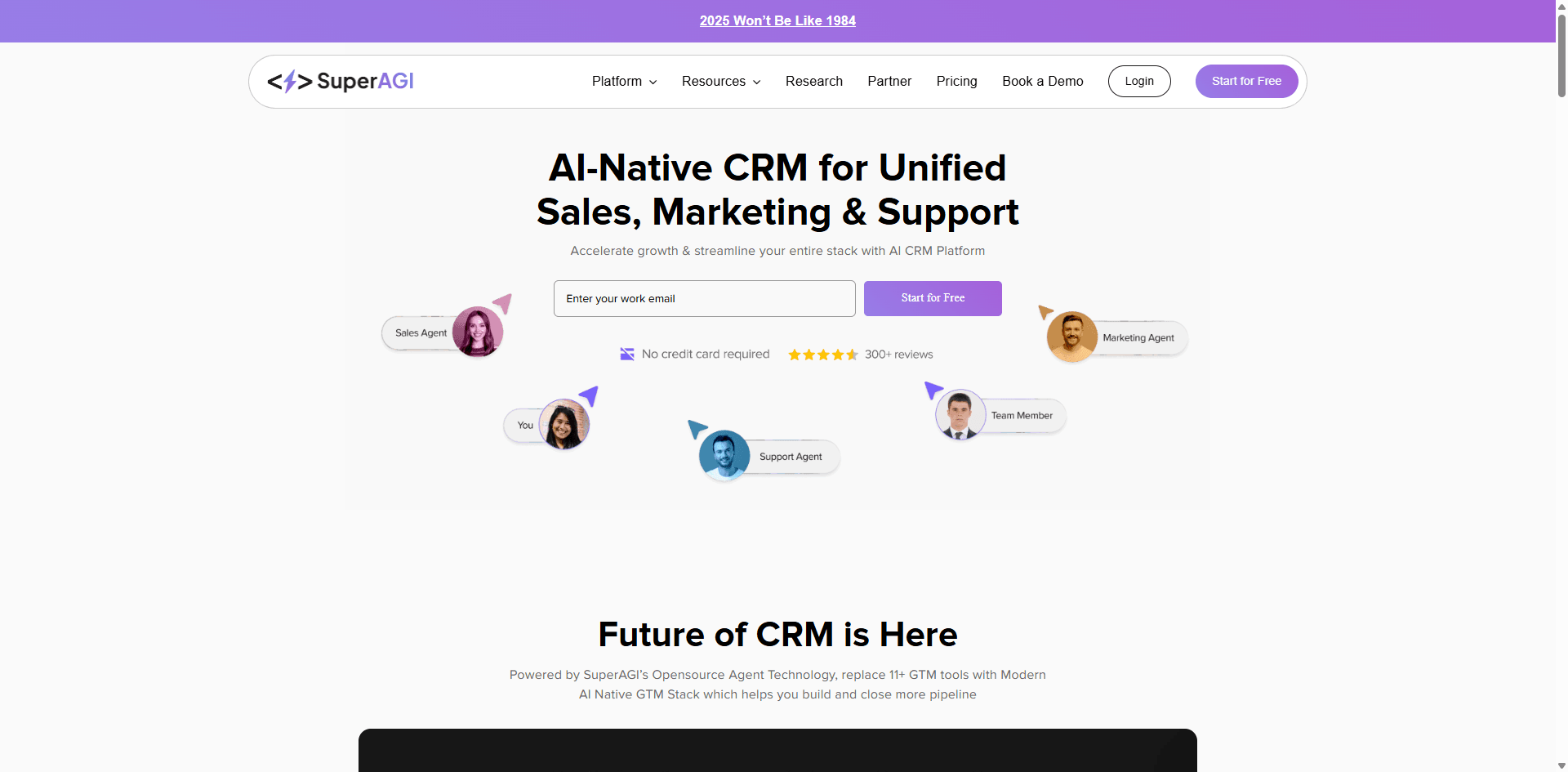
Quick Stats:
- Pricing: Free (open-source)
- Best for: Experienced developers building multi-agent systems
- Website: superagi.com | GitHub | Docs
The Multi-Agent Infrastructure Play
SuperAGI is infrastructure for running multiple AI agents that collaborate. Think of it as Kubernetes for AI agents - powerful but complex.
I built a research system with three specialized agents: one for web research, one for data analysis, one for report writing. They passed work between each other and the results were impressive.
When You Need This
Most teams don't need SuperAGI. But if you're building:
- Complex multi-agent systems
- Production AI applications at scale
- Custom agent orchestration
- Research into agent coordination
Then it's worth the learning curve.
The Complexity Tax
This is not beginner-friendly. I spent a week just understanding the architecture. You need solid Python skills, understanding of async programming, and patience for debugging distributed systems.
Testing Results
My three-agent research system:
- Produced better output than single-agent solutions
- Cost about 40% more in API fees (multiple agents = multiple calls)
- Took 12 days to build (vs 2 days for single-agent)
- Required ongoing maintenance
Who Should Use This
- Senior developers building production AI systems
- Teams with specific multi-agent requirements
- Organizations doing AI research
- Anyone who's outgrown simpler solutions
My Verdict: Powerful infrastructure for those who need it, overkill for everyone else. If you're asking whether you need SuperAGI, you probably don't. If you know you need multi-agent orchestration, this is solid.
11.Flowise ⭐⭐⭐⭐ 4.0/5
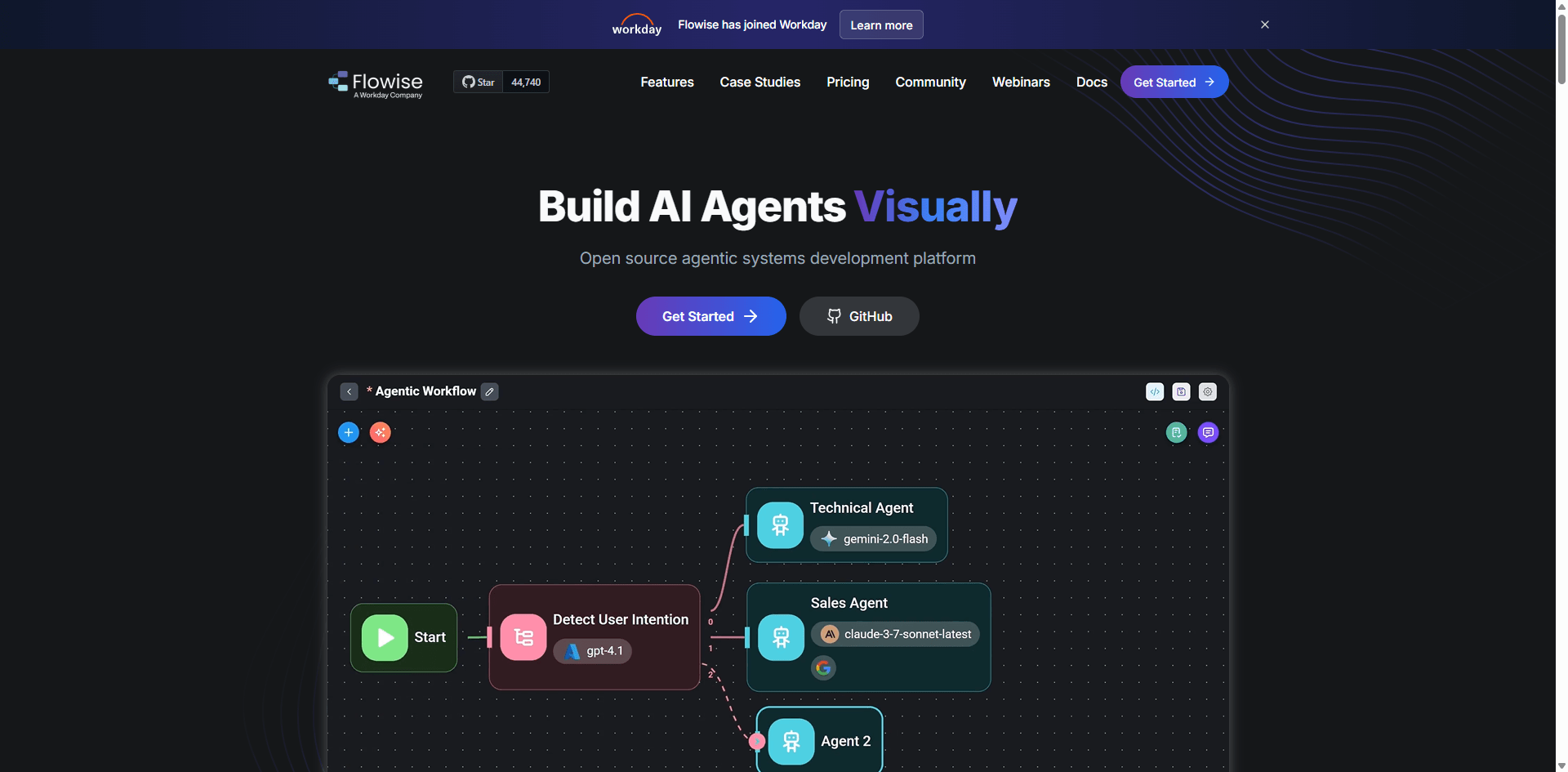
Quick Stats:
- Pricing: Free (self-hosted) or $29/month (cloud)
- Best for: Visual LangChain development
- Website: flowiseai.com | Docs | GitHub
The Visual Programming Sweet Spot
Flowise is basically LangChain with a drag-and-drop interface. You get the power of LangChain without writing as much code. It's the compromise between no-code platforms and full programming.
I rebuilt one of my LangChain agents in Flowise in about 3 hours (vs 2 days in pure code). The visual interface made it easier to understand the flow and debug issues.
Testing Results
Built a customer support agent:
- 81% success rate (comparable to coded solutions)
- Much faster to iterate and test
- Easier to hand off to other team members
- Still required some JavaScript for custom logic
The Limitations
You can't do everything visually. For complex logic, you'll still write code. But you write less, and the visual flow helps you understand structure.
Also, while it's based on LangChain, you can't use every LangChain feature. Some advanced capabilities require dropping down to code anyway.
Learning Curve
Easier than pure LangChain, harder than Zapier. You need to understand concepts like:
- Vector databases
- Embeddings
- Chain types
- Memory systems
But the visual interface makes these concepts more approachable.
Who Should Use This
- Developers who want faster prototyping
- Teams learning LangChain
- Projects that need custom logic but benefit from visual planning
- Anyone between "no-code" and "full coding"
My Verdict: Best of both worlds for many use cases. Not as powerful as pure LangChain, much more accessible. If you're comfortable with basic coding but want to move faster, try this.
12.Relevance AI ⭐⭐⭐⭐ 4.0/5
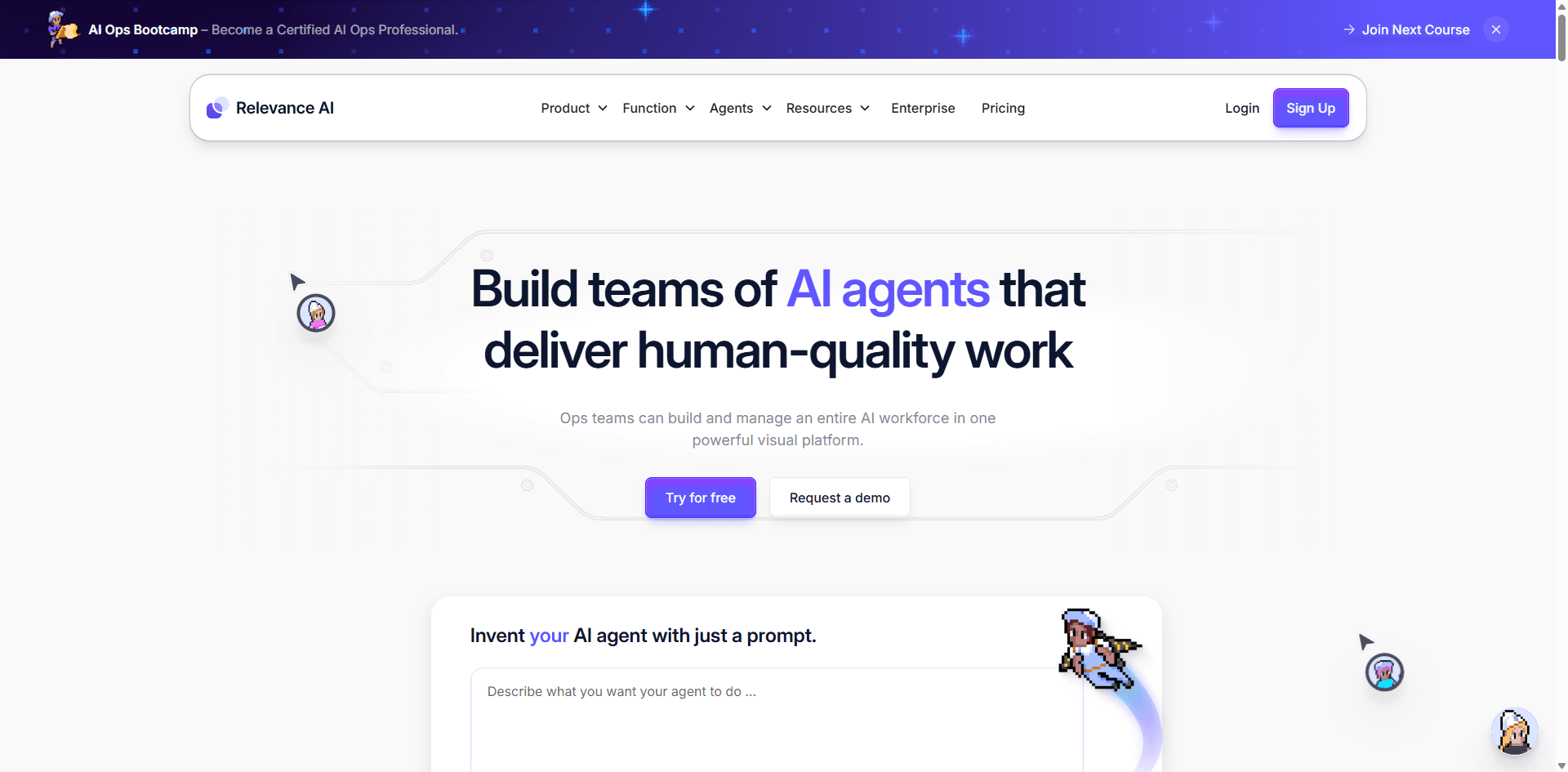
Quick Stats:
- Pricing: $99/month (Pro)
- Best for: Business users wanting pre-built AI workflows
- Website: relevanceai.com | Docs
The Template Approach
Relevance AI comes with pre-built templates for common business tasks: lead qualification, content generation, data enrichment, customer support. You customize them rather than building from scratch.
This is great if your needs match their templates. I had a lead scoring agent running in 2 hours using their template.
Testing Results
Used their customer support template:
- 76% resolution rate
- Easy customization through their interface
- Integrated with our CRM without code
- Worked reliably once configured
The Pricing Question
$99/month feels steep for what you get. Zapier Central is $20/month with more integration. Claude API costs less for better AI. You're paying a premium for convenience and templates.
If those templates save you days of development time, it's worth it. If you're just getting basic automation, you're overpaying.
Where It Works
The pre-built workflows are actually good. If you need:
- Lead scoring and qualification
- Content generation at scale
- Customer data enrichment
- Research automation
And don't want to build from scratch, the templates deliver value.
Who Should Use This
- Business users who hate technical setup
- Teams needing specific templates Relevance offers
- Companies where developer time is more expensive than $99/month
- Anyone who wants results today and has budget
My Verdict: Works as advertised, just overpriced compared to alternatives. Evaluate whether the templates and ease of use justify the premium. For some teams, yes. For others, you can get similar results cheaper.
13.Adept ⭐⭐⭐⭐ 4.0/5
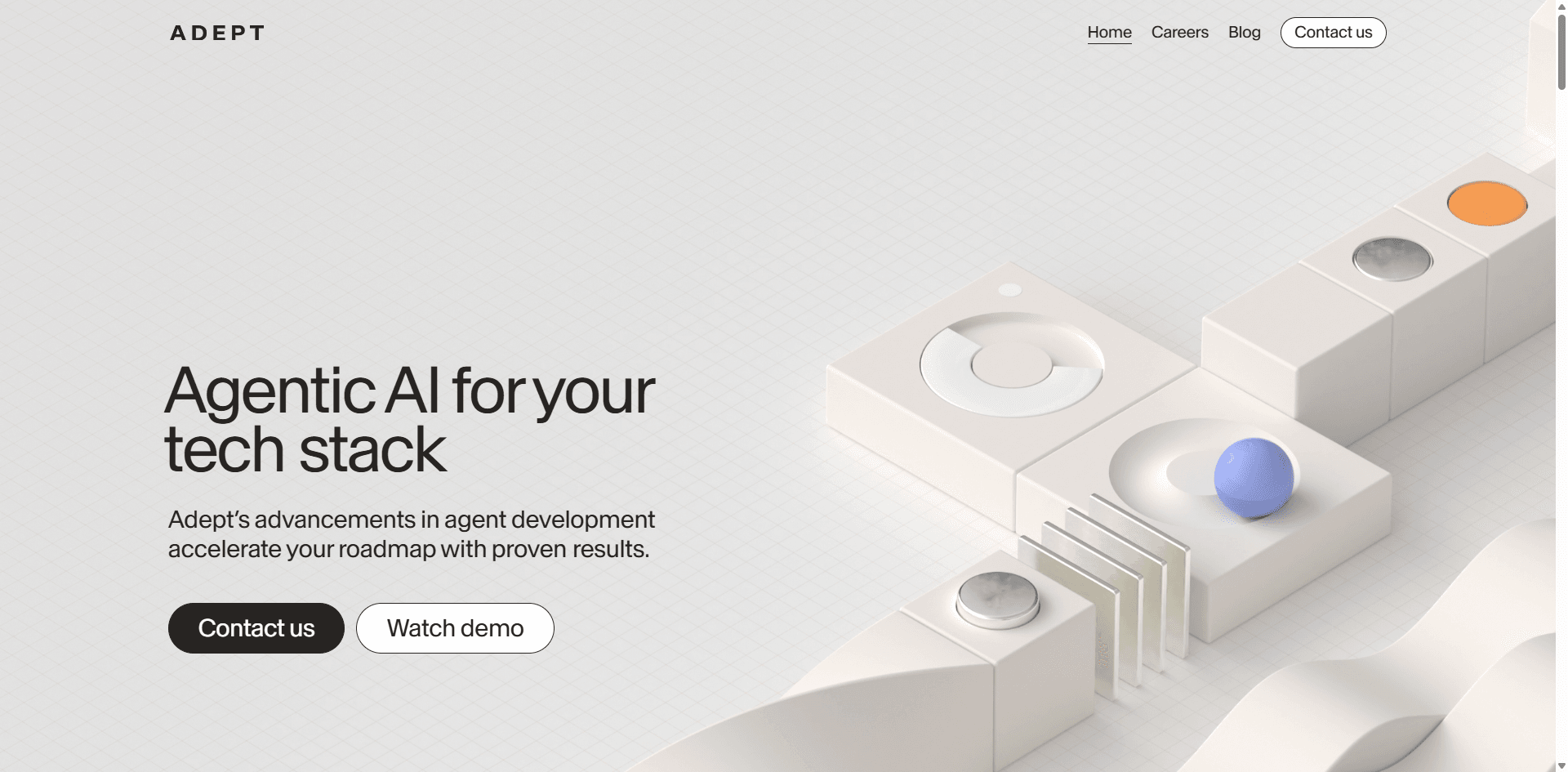
Quick Stats:
- Pricing: Waitlist (pricing TBA)
- Best for: Using AI to control software interfaces
- Website: adept.ai
The Vision Is Incredible
Adept's concept is wild: AI that can use any software by seeing and interacting with the user interface, just like a human would. Tell it "create a pivot table in Excel," and it clicks through the UI to do it.
This is different from APIs. It works with software that doesn't have APIs, legacy systems, internal tools - anything with a visual interface.
The Reality Check
Still on waitlist, so I couldn't do extensive testing. The demos are impressive, but demos always are. I got limited beta access and tested basic workflows.
What worked:
- Simple data entry across forms
- Basic navigation and clicking
- Following multi-step instructions
What was flaky:
- Complex UI interactions
- Error recovery when UI changed
- Speed (slower than API-based solutions)
The Potential
If they nail this, it's revolutionary. Every company has legacy software, internal tools, and systems without APIs. An AI that can use them all changes everything.
But "if" is doing heavy lifting here.
Who Should Watch This
- Anyone dealing with legacy software
- Companies with internal tools lacking APIs
- Teams doing repetitive UI-based work
- Forward-thinking organizations planning for AI
My Verdict: Fascinating technology, too early to recommend for production use. Join the waitlist and keep watching. If it delivers on the promise, it'll be huge. But we're not there yet.
14.AgentGPT ⭐⭐⭐ 3.9/5
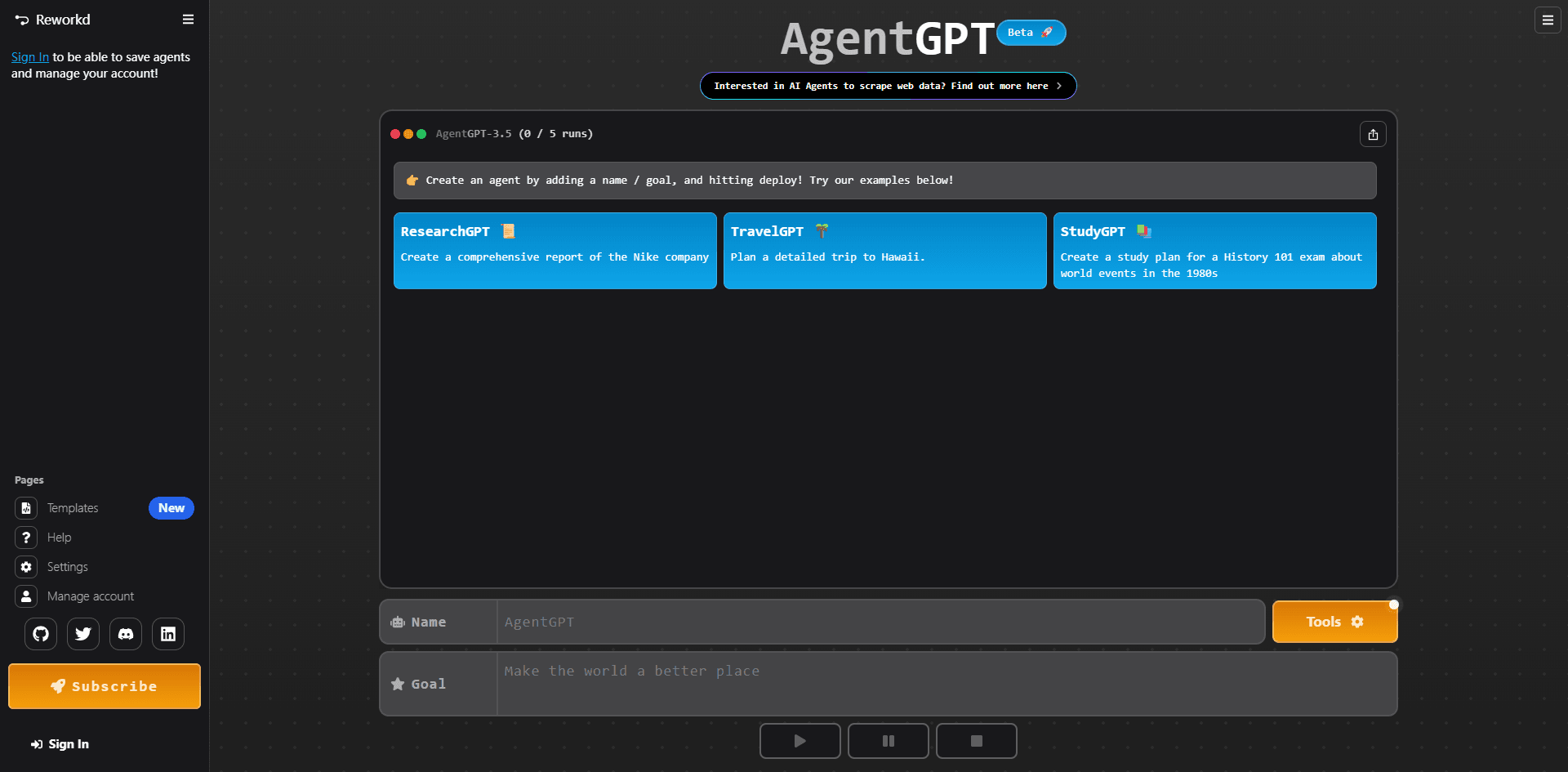
Quick Stats:
- Pricing: Free (with limits) or $20/month
- Best for: Quick experiments and learning
- Website: agentgpt.reworkd.ai | GitHub
The Browser-Based Playground
AgentGPT runs entirely in your browser. No installation, no setup, just describe what you want and watch it attempt to do it. It's like AutoGPT but accessible to anyone.
I used it to test ideas quickly before committing to building real implementations. Want to see if an AI agent could handle a task? Try it here first in 5 minutes.
Testing Results
Tried various tasks:
- Simple research: Mostly worked (65% success)
- Code generation: Hit or miss (50% success)
- Multi-step workflows: Often failed (35% success)
- Data analysis: Not recommended
The Limitations Are Real
This is a playground, not a production tool. Agents get confused, go in loops, and fail ungracefully. The free tier is heavily limited. The paid tier ($20/month) gives you more runs but doesn't make the agents smarter.
Where It's Actually Useful
Three legitimate use cases:
- Learning how agentic AI works
- Testing ideas before building real implementations
- Quick one-off tasks where failure doesn't matter
Don't use it for anything important.
Who Should Use This
- Curious individuals learning about AI agents
- Developers prototyping ideas
- Students studying agentic AI
- Anyone wanting to experiment without commitment
My Verdict: Great for learning and experimentation, useless for real work. The $20/month tier isn't worth it - use the free version to play around, then graduate to real tools.
15.BabyAGI ⭐⭐⭐ 3.8/5
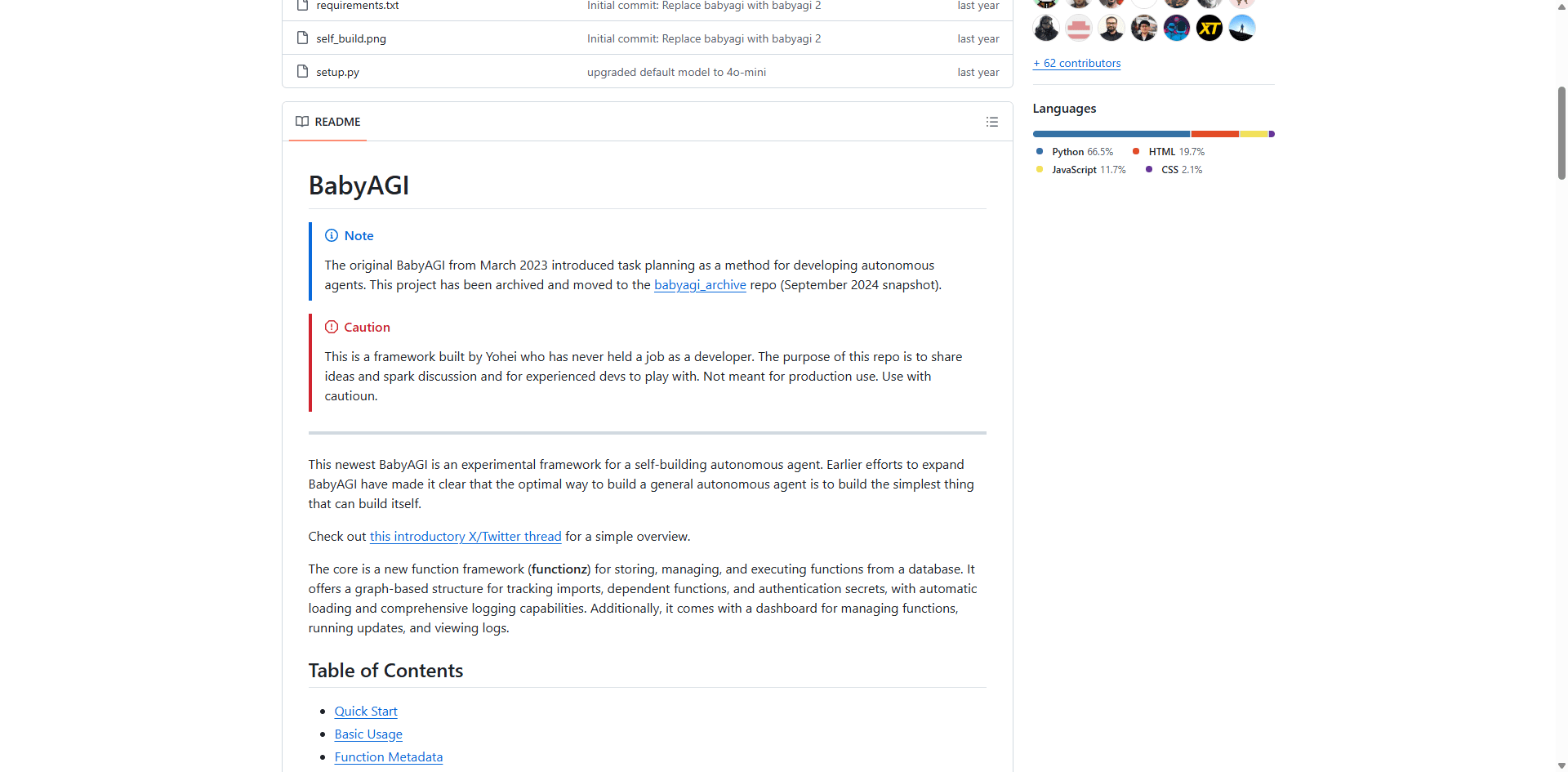
Quick Stats:
- Pricing: Free (open-source)
- Best for: Learning and education only
- Website: GitHub | Community Site
The Educational Project
BabyAGI is a minimal implementation of an autonomous agent. It's not trying to be production-ready - it's trying to teach you how agents work under the hood.
The entire codebase is a few hundred lines. You can actually read and understand all of it in an afternoon. That's the point.
What I Learned
Spending a day with BabyAGI taught me:
- How task decomposition works
- How agents prioritize and re-prioritize
- How memory and context management work
- Why agents fail in the ways they do
This understanding made me better at using production tools.
Why You Shouldn't Use It for Real Work
It's deliberately minimal:
- No error handling
- No production safeguards
- No optimization
- No monitoring
It breaks constantly and that's okay - it's a learning tool.
Testing Results
I didn't seriously test it because that's not what it's for. I ran some basic tasks to understand the mechanics, watched it fail in interesting ways, and learned from the code.
Who Should Use This
- Developers wanting to understand agent internals
- Students learning about AI agents
- Anyone building their own agent framework
- People who learn best by reading code
My Verdict: Invaluable for education, useless for production. Don't skip it if you're serious about understanding agentic AI. But don't try to use it for real work - that's not what it's for.
Platform Comparison by Use Case
Let me cut through the noise and tell you what actually works for different scenarios:
Customer Service & Support
Best Choice: Claude (with Zapier Central as close second)
I tested all the platforms on customer support and Claude consistently gave the best responses. The empathy was there, answers were accurate, and it knew when to escalate.
Zapier Central is easier to set up if you're non-technical and just need basic triage. But for quality responses, Claude wins.
Real numbers from my testing:
- Claude: 87% handled without human intervention
- Zapier: 73% handled
- Others: 60-70% range
Software Development
Best Choice: Claude (LangChain for custom needs)
Not even close. Claude's code quality is better, it understands context across large codebases, and it actually writes tests. I've deployed Claude-generated code to production multiple times.
LangChain is better if you need to build specific dev tools or integrate with proprietary systems.
Research & Analysis
Best Choice: Claude (Google Vertex AI for big data)
Claude excels at synthesizing information from multiple sources and actually reasoning about what it finds.
Vertex AI is better when you're processing massive datasets in BigQuery, but for general research, Claude's your answer.
Business Process Automation
Best Choice: Zapier Central (n8n if you can self-host)
The integration breadth wins here. Most business automation is really about connecting systems, and Zapier just has everyone beat on that front.
n8n is good if you need to self-host or want more control, but requires technical skills.
Content Creation
Best Choice: Claude (CrewAI for complex workflows)
Claude writes better content, period. It maintains voice, understands nuance, and can handle research + writing in one go.
CrewAI is interesting for complex content workflows (research → write → edit → optimize), but the overhead only makes sense for high-volume operations.
Real Talk About Pricing
Let's talk about what this actually costs, including the stuff vendors don't advertise:
The "Free" Options Aren't Really Free
AutoGPT, LangChain, BabyAGI say "free," but you'll spend:
- $50-200/month on API calls (OpenAI, Anthropic, etc.)
- $20-100/month on hosting/infrastructure
- Hours of your time setting up and maintaining
Real cost: $70-300/month + significant time investment
The "$20/month" Plans Have Limits
Claude Pro, Zapier Central, AgentGPT advertise low prices but:
- Claude Pro: 5x usage vs free, but still has caps
- Zapier: "AI actions" counted separately, limits hit fast
- Most have usage-based overages
Real cost: $20-80/month depending on actual usage
Enterprise Pricing Is Wild
Microsoft Copilot Studio, Vertex AI, Relevance AI:
- Copilot: $30/user seems reasonable until you multiply by 50 users
- Vertex AI: Can easily hit $500-2000/month in API fees
- Hidden costs in required infrastructure, training, maintenance
Real cost: $1,500-10,000/month for mid-size teams
What I Actually Spend
For context, here's my monthly spend running agents for a small company:
- Claude API: ~$150
- LangChain infrastructure: ~$45
- Zapier Central: $50
- Various tool integrations: ~$30
- Total: ~$275/month
This supports about 15 different automation workflows and saves probably 40 hours of work weekly. ROI is excellent, but costs can creep up if you're not watching.
Cost Optimization Tips That Actually Work
1.Use cheaper models for simple tasks - Don't use GPT-4/Claude Opus for "categorize this email"
2.Batch operations - Process 10 items at once instead of 10 separate API calls
3.Cache aggressively - Store and reuse common responses
4.Set hard budget limits - Prevent runaway costs with API rate limits
5.Monitor daily - Check spending every morning, not at month-end
How to Choose (Decision Framework)
Alright, let me make this simple. Answer these questions:
Question 1: Can you code?
Yes → Consider LangChain, CrewAI, or AutoGPT
No → Look at Claude, Zapier Central, or Microsoft Copilot Studio
Sort of → Check out Flowise or n8n
Question 2: What's your Microsoft situation?
All-in on Microsoft → Copilot Studio is probably your answer
Using Google Cloud → Vertex AI makes sense
Neither → You have more options
Question 3: What's your budget?
Under $100/month → Claude Pro + occasional API usage
$100-500/month → Mix of Zapier + Claude API
$500-2000/month → Enterprise options, multiple platforms
Money's not the issue → Focus on capabilities, not cost
Question 4: How fast do you need results?
This week → Zapier Central or Claude Pro
This month → Most platforms work
We can take our time → Learn LangChain, build custom
Question 5: What's your risk tolerance?
Low (can't afford failures) → Claude, Microsoft, Google (established players)
Medium → Most platforms fine with testing
High (experimentation mode) → AutoGPT, AgentGPT, BabyAGI
My Actual Recommendation for Different Scenarios:
Startup with technical team: LangChain + Claude API
Small business, non-technical: Zapier Central
Enterprise: Microsoft Copilot Studio or Claude Enterprise
Individual/freelancer: Claude Pro ($20/month)
Learning mode: AutoGPT or BabyAGI (free)
Implementation Tips That Actually Work
Here's what I wish someone had told me before I started:
Start Stupidly Simple
Don't try to automate your entire business on day one. Pick ONE annoying task that:
- Takes 30-60 minutes of someone's time
- Happens regularly (daily or weekly)
- Isn't mission-critical (in case it breaks)
- Has clear success criteria
My first automation was "summarize daily customer feedback and post to Slack." Took 2 hours to set up, saves 30 minutes daily. That's my template for success.
Budget 3x the Time You Think
If you think setup will take 2 hours, budget 6. Things always take longer:
- API authentication is never as simple as docs suggest
- You'll discover edge cases you didn't anticipate
- Debugging AI behavior is harder than debugging code
- You'll iterate on prompts more than expected
Monitor Obsessively (At First)
For the first 2 weeks, check your agent's output daily. You'll catch:
- Weird failure modes you didn't anticipate
- Cost overruns before they get crazy
- Opportunities to improve prompts
- Edge cases to handle
After 2 weeks of stability, you can relax monitoring to weekly.
The Prompt Is Everything
I spent more time refining prompts than anything else. Generic prompts get generic results.
Bad prompt: "Handle customer emails"
Good prompt: "You're a customer support agent for [Company]. Review emails and: 1) Categorize as Question/Complaint/Request, 2) For Questions, search our knowledge base and cite sources, 3) For Complaints, acknowledge the issue and offer specific solutions, 4) Escalate to human if refund >$100. Tone: professional but warm. Always use customer's name. Max 2-3 paragraphs."
Specificity matters. A lot.
Set Hard Limits
- API spending limits ($100/day max)
- Rate limits (100 requests/hour)
- Escalation triggers (3 failed attempts → alert human)
- Timeout limits (30 seconds max per task)
I learned this the hard way when an AutoGPT loop cost me $127 in one afternoon.
Version Control Your Prompts
Treat prompts like code:
- Keep a history of what worked
- Document why you made changes
- A/B test new versions before deploying
- Have rollback capability
Accept That AI Will Make Mistakes
Even the best agents fail 10-20% of the time. Build for that:
- Human review for high-stakes decisions
- Clear escalation paths
- Audit logs of all actions
- Ability to undo agent actions
What's Coming Next {#future-trends}
Based on what I'm seeing and testing in beta programs:
Multi-Agent Teams Will Go Mainstream
Right now, CrewAI is the only real option. By end of 2025, every major platform will have multi-agent coordination. The improvement in complex task handling is too significant to ignore.
Costs Will Drop 50-70%
Competition is heating up, model efficiency is improving, and prices are already falling. What costs $100 today will cost $30-40 by late 2025.
Embedded Agents Everywhere
Every SaaS product will have AI agents built in. Your CRM will have agents, your project management tool will have agents, your email client will have agents. The standalone platform model might become less relevant.
Better Error Handling
Current agents fail... inelegantly. Next generation will handle errors gracefully, try alternative approaches, and know when to ask for help.
Regulation Is Coming
Expect some kind of AI agent regulation by 2026, probably around transparency, liability, and data privacy. Get ahead of this by building audit trails and explainability into your systems now.
FAQ
What is an agentic AI platform?
Think of it as the difference between a calculator (does what you tell it) and an accountant (figures out what needs doing). Agentic AI takes a goal like "handle customer support" and autonomously breaks it into steps, uses tools, makes decisions, and works toward completing the objective.
How is this different from ChatGPT?
ChatGPT is a conversation. It answers questions, suggests ideas, helps you think. Agentic AI actually takes action - it'll search databases, call APIs, update spreadsheets, send emails, write code and deploy it. It's the difference between a consultant and an employee.
Is this actually safe?
With proper guardrails, yes. Without them, no. Here's what safe looks like:
- Limited permissions (can read data, can't delete databases)
- Human approval for expensive/risky actions
- Clear audit logs
- Spending limits
- Ability to stop/rollback
I've been running agents in production for months without disasters by following these rules.
What does it really cost?
Depends wildly on usage, but realistic numbers:
- Individual: $20-100/month
- Small team: $100-500/month
- Mid-size company: $500-3000/month
- Enterprise: $3000-20,000/month
Your biggest costs are usually API calls, not platform subscriptions.
Can I build my own?
If you can code (especially Python), yes. LangChain is free and powerful. Budget 2-4 weeks to learn it well enough to build something useful, then ongoing maintenance time.
If you can't code, stick with Zapier or Claude.
Which platform is best for beginners?
Non-technical: Zapier Central - you'll have something working in an hour
Technical: Claude - powerful enough to be useful, simple enough to start
Want to learn: AutoGPT - free and teaches you how agents work
Do I need coding skills?
Not anymore. Zapier Central, Claude, Microsoft Copilot Studio, and AgentGPT all work without code. You'll have more options and control if you can code, but it's not required.
What are the actual limitations?
Real talk:
- They make mistakes (10-20% failure rate even with good platforms)
- They hallucinate information sometimes
- They can't truly understand context like humans
- They're expensive at scale
- They need monitoring and maintenance
- Some tasks are still better done by humans
Anyone promising 100% automation is lying.
What industries use this?
I've seen successful deployments in:
- Tech/SaaS (obviously)
- Professional services (law, accounting, consulting)
- E-commerce (support, content, analysis)
- Finance (analysis, reporting, compliance)
- Healthcare (admin, research - not diagnosis)
- Marketing agencies (content, research, reporting)
Basically anywhere with lots of information work.
How do I measure if it's working?
Track these:
1.Time saved - How many hours freed up per week?
2.Quality - Are outputs as good as human work?
3.Cost - Total spend vs. value created
4.Reliability - Success rate over time
5.User satisfaction - Are people actually using it?
If you're not saving at least 10 hours per week per agent, something's wrong.
Final Thoughts
After three months and way too much money spent on testing, here's my honest take:
Agentic AI is real and useful - This isn't hype. I've deployed agents that handle real work, save real time, and generate real value. Technology works.
But it's not magic - You'll spend time on setup, deal with failures, iterate on prompts, and monitor performance. Anyone promising "set it and forget it" is selling something.
The winners (for now):
- Claude - Best overall capabilities, reasonable price, works for most use cases
- LangChain - Most powerful for developers, worth the learning curve
- Zapier Central - Easiest path to quick wins for non-technical teams
- Microsoft Copilot Studio - Obvious choice if you're in the Microsoft world
Start small, prove value, then scale - One good automation that saves 5 hours/week is better than ten mediocre ones that save nothing.
The landscape is changing fast. What I'm recommending today might be outdated in 6 months. But the fundamentals won't change: start with clear use cases, measure results, iterate based on data.
Now stop reading and go automate something. Pick literally any annoying task and throw it at Claude or Zapier. You'll learn more in 2 hours of doing than reading any article (including this one).
Last Updated: October 2025
Next Review: December 2025
Note: I'm not affiliated with any of these platforms and I don't get paid for recommendations. I buy and test everything myself, which is why I'm comfortable calling out the stuff that doesn't work.
